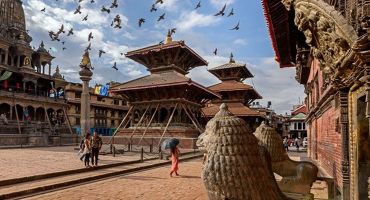As Yalambar conquered Nepal valley (Kathmandu) beginning from Sangha (East Kathmandu) to Gokarna (north Kathmandu), he consolidated his empire completely by taking over Jolpringram (modern day Thankot) in around 600 B.C (Date Source: Jayaswal Vamshali, 1928). Thankot was named “Jolpringram” by the Kiratas. The word “gram” used as a suffix in the name “Jolpringram” suggests that it was an important town during the Kirata era. The Kiratas also used the term “pringga” to denote any settlement or village on a “hill”. The name “Jol-prin-gram” uses both the suffixes respectively, “pringga” and “gram”. Needless to say, anyone who has ever been to Kathmandu knows that Thankot is located on a hill. When the Lichhavis took over the Nepal valley, they also took over already existing Kirata towns and made it their own. The Lichhavis changed the name “Jolpringram” to “Jayapalikagram” and made it their trade hub. Thus, most towns of the Kirata era are today important centers of modern Kathmandu.
Of all the significant places that are important to the ancient Kirata heritage in the Kathmandu valley, Patan obviously stands as the most important among them all. It is in this place that the Kiratas put up their last stand as a ruling civilization and which lives to testify the consummate dexterity of Kirata town planning. It is without a doubt that we can assume that the Kiratas were the ones who introduced brick work in Nepal. The Hadigaon excavations, where bricks built as early 160 B.C were unearthed, prove that the Kiratas could have been using bricks for constructions. Amazingly, Patan’s alleyways, which have an uncanny similarity to the Harrapan towns of the Indus Valley, are but remains of their ingenious town planning, brick work and masonry. So influential was the Kirata civilization that even today the locals call Kathmandu, Patan and Bhaktapur, Ya, Yala, Khope respectively. These are all ancient Kirata names of these places.
When the 28th King Patuka’s Gokarna Kingdom was being constantly attacked by the Lichhavis, he shifted his capital by the banks of the Bagmati river in Shankamul, an extended part of the town of Patan. But why did he choose Patan among all the places in the Kathmandu valley? There can be more than one answer to that. Patan would be strategically protected by two rivers; Bagmati and Hanumante. It is also situated at a significant altitude so to capture it would be a daunting task. Patan was obviously considered a holy place by the Kiratas, hence they perhaps believed it was a protected zone. Ashoka would never build his famous stupas in 250 B.C around Patan, if he had not considered it a holy place.
It is believed that Patuka, who was enthroned in around 85 A.D must have shifted his capital to Patan in around 110 A.D. Technically the capital that he built was supposed to have lasted another 150 years but the exact dates are still a matter of speculation. But Patuka did leave behind a legacy. His palace ruin (Patuka Mound) is one of the most conclusive proofs of Patan being a Kirata dominion other than the fact that the word “Patan” is derived from his own name.





Pradeepji, your dedication to illuminating our stories and safeguarding them for future generations is truly inspiring. Thank you. I look forward to witnessing the continued growth of this endeavor in the future.
Thank you very much. Your comment is greatly valued and appreciated.
Thank you for the encouragement. I really appreciate it.